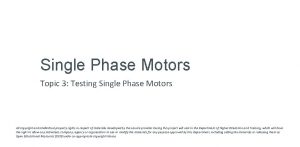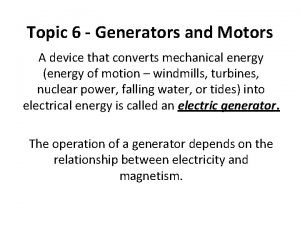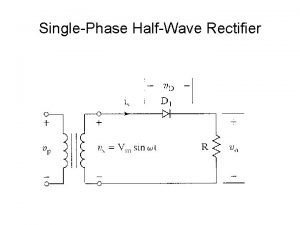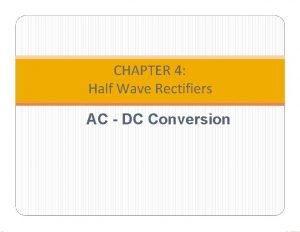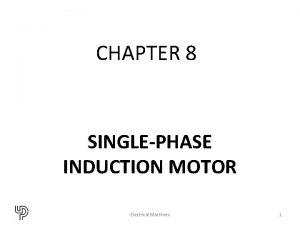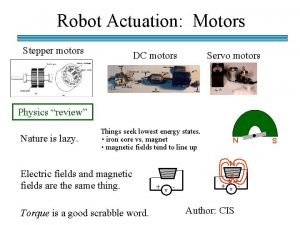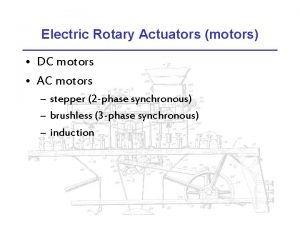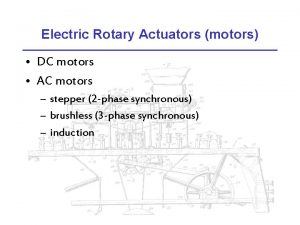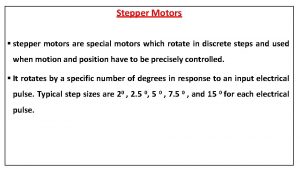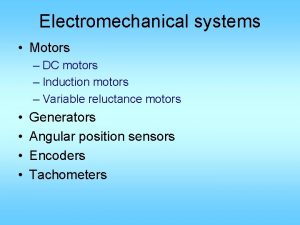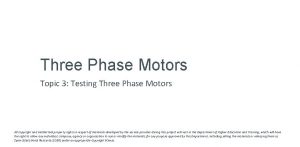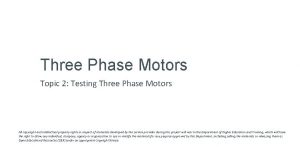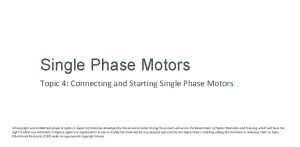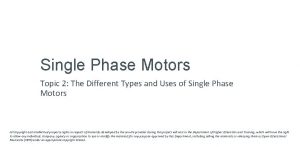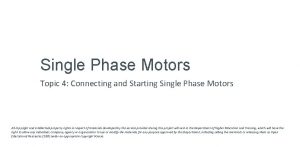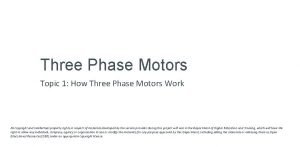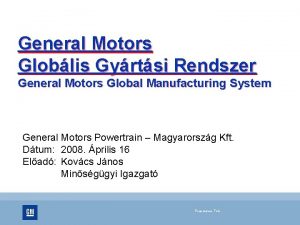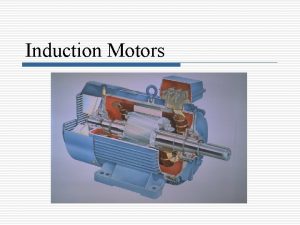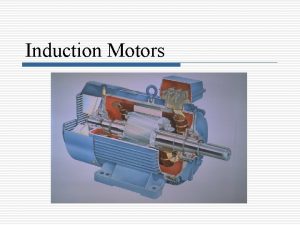Single Phase Motors Topic 3 Testing Single Phase





![Introduction [Img 1]You work for a large food retailer and receive a call that Introduction [Img 1]You work for a large food retailer and receive a call that](https://slidetodoc.com/presentation_image/01bd4742f79c62762445e2a04abf6025/image-6.jpg)






































- Slides: 44

Single Phase Motors Topic 3: Testing Single Phase Motors All copyright and intellectual property rights in respect of materials developed by the service provider during this project will vest in the Department of Higher Education and Training, which will have the right to allow any individual, company, agency or organisation to use or modify the materials for any purpose approved by this Department, including selling the materials or releasing them as Open Educational Resources (OER) under an appropriate copyright license.

Assumed prior learning 05_01_00 05_01_02 05_02_01

Outcomes By the end of this unit the learner will: 1. List the necessary single phase motor electrical tests 2. Perform continuity tests on single phase motors 3. Perform capacitor tests on single phase motors 4. Perform insulation resistance tests on single phase motors 5. Complete a motor test form with the results of electrical tests

Unit 3. 1: Single Phase Motor Electrical Tests

Introduction Nothing in life is perfect and single phase AC motors are the same. They need to be regularly checked, tested and repaired to keep them in running order. Sometimes things break and then we need to test motors to find out why. Some motor faults can even lead to death like when there is a short circuit between the windings and the motor frame. In this unit, we are going to learn about how to do all the necessary electrical tests on a single phase motor.
![Introduction Img 1You work for a large food retailer and receive a call that Introduction [Img 1]You work for a large food retailer and receive a call that](https://slidetodoc.com/presentation_image/01bd4742f79c62762445e2a04abf6025/image-6.jpg)
Introduction [Img 1]You work for a large food retailer and receive a call that one of the roller doors at the main warehouse is not working. Your job is to test the single phase motor controlling the door and see if you can figure out what is wrong with it.

Safety first When you work with motors you must put your safety and the safety of others first. You must complete the necessary Hazard Identification and Control (HIAC) Form. Need help with HIACs? Click the button to go to Topic X in The World of an Electrician Get help with HIAC Forms

Potential Hazards Here are some of the potential hazards you should look out for: Vehicles, traffic or mobile equipment Working at heights above 2 m Hazardous Materials or Waste Lifting and material handling Electricity, machinery, stored energy or machine isolation Work with Oxy-fuel gas mixtures

What are the Potential Hazards? You need to test a single phase AC motor. 1. It operates a 2. 5 m high roller door for a delivery truck entrance. 2. The motor is mounted on a bracket next to the roller mechanism. Identify all the hazards that are present. Img 02 Identify the hazards

Potential Hazards Which hazards apply to this situation? Drag them onto the picture. Vehicles, traffic or mobile equipment Hazardous Materials or Waste Working at heights above 2 m Lifting and material handling Electricity, machinery, stored energy or machine isolation Work with Oxy-fuel gas mixtures Check Img 02

Stop and Check? Because there are some potential hazards associated with this job, you need to check that all the necessary safety controls related to these hazards are in place. If you are not sure what these safety controls are, you should stop this unit and refer back to Topic X in The World of an Electrician before continuing. Learn about Safety Controls

Before We Begin Before you do any electrical tests, you must make sure that you have isolated and locked out the supply to the motor. Make sure you know how to do this by referring to Topic X in The World of An Electrician. Learn about Isolating and Lock-Out Procedures

Be Prepared Once you have 1. Identified all potential hazards 2. Made sure the necessary safety controls are in place 3. Isolated and locked out the motor, you can prepare to start your tests. Click on each box to learn more. 1 Check you multimeter 2 Open the terminal box 3 Remove the bridge pieces

Open the Terminal Box You do not need to open up the motor to test it. You can access all the motor’s electrical components and terminals from inside the terminal box. Img 05 Look out for a wiring diagram on the inside of the terminal box cover showing how everything is connected to the terminal block Img 06

Remove the Bridge Pieces You might see some of the terminals connected or bridged with strips of metal. These allow you to control the direction of the motor. Img 08 If you see bridge pieces, disconnect them. Img 09

A Note on Wiring Diagrams The names that different manufacturers give to each terminal may differ but U 1, V 1, W 1, U 2, V 2 and W 2 are quite common. The wiring diagram gives details about how to wire the motor including where to place the bridge pieces in order to control its direction. Take note of the wire colours that are given.

Types of Electrical Tests There are basically three types of electrical tests that you need to be able to do on single phase AC motors. Click on each box to find out more. Continuity Tests Capacitor Tests Insulation Resistance Tests

Continuity Tests Now you are ready to start with the continuity tests. Click each step to see what to do. Step 1 Step 3 Step 2 Step 4

Step 1 Set your multimeter to the continuity setting which is often the same as the low Ω setting. Img 10

Step 2 1. Draw the terminal block connections on a piece of paper if you do not have a printed diagram. 2. If there is a wiring diagram available label the terminals in your diagram like the wiring diagram. 3. Make sure that you have an electrical checklist to note down all your test results. Img 11 Img 12

Step 3 1. Clip the black lead onto the top left terminal and test each of the other terminals to see which one shows continuity. 2. Your multimeter will show a resistance value and might beep. 3. Mark these two terminals and note the total resistance. Img 13 Img 14

Step 4 1. Connect the black lead to the next terminal and repeat the process until you have connected the black lead to all of the terminals. 2. Mark which terminals are connected and what the resistance value is in each case. Img 15

Doing a Continuity Test Watch a video to see how to do a continuity test and to learn what the readings mean. Vid 01

Complete a Motor Test Form Here is part of a typical motor test form. Img 16 See the test values 1. Click on the image to download the form or make your own. 2. Look at the test values. 3. Indicate the following: 1. Start windings 2. Run windings 3. Centrifugal switch

Test Values W 2 – U 2: None W 2 – V 2: 0, 4Ω W 2 – U 1: None W 2 – V 1: None W 2 – W 1: None U 2 – V 3: None U 2 – U 1: None U 2 – V 1: None U 2 – W 1: 21, 4Ω V 2 – U 1: None V 2 – V 1: None V 2 – W 1: None U 1 – V 1: 7, 3Ω U 1 – W 1: None V 1 – W 1: None

Upload Your Motor Test Form Take a picture of your completed form and upload it. Make sure you have labelled the block diagram with which connections represent the start winding, the run winding and the centrifugal switch and what these resistance values are. Choose image Upload

Your Motor Test Form Your completed form should have looked something like this. 1. The centrifugal switch has a resistance close to zero. 2. The start winding always has a resistance greater than the run winding. Img 18

What’s the Problem? Look at the test results and decide what is wrong with this motor. See the test results a) The run winding is damaged b) The start winding is damaged c) The centrifugal switch is damaged d) There is nothing wrong

Test Values T 1 – T 2: None T 1 – T 3: 0, 4Ω T 1 – T 3: None T 1 – T 5: None T 1 – T 6: None T 2 – T 3: None T 2 – T 4: None T 2 – T 5: None T 2 – T 6: 21, 4Ω T 3 – T 4: None T 3 – T 5: None T 3 – T 6: None T 4 – T 5: 7, 3Ω T 4 – T 6: None T 5 – T 6: None

Complete the Motor Test Form Here is a full motor test form. 1. Download this form or create your own. 2. Complete the relevant section with the test results provided on the previous screen. See the test results again Img 19 a Download

Capacitor Test We need to test the motor’s capacitor to see if an open or short circuit condition exists. Generally, if a capacitor is found to be faulty, it must be replaced. Vid 02 Watch the video to learn how to test a capacitor

Remember - Use the Right Instrument! It is best to do a capacitor test with a good quality analogue multimeter. You must NEVER use an insulation resistance tester like the BM 6 Megger to test a capacitor. When the capacitor discharges, it will destroy the instrument. Img 21

Complete the Motor Test Form Continue to complete your full motor test form with the results of these capacitor tests. Img 19 a See the test results Download

Insulation Resistance Tests Img 22 Electricity is very useful but only when it flows where we want it to! 1 Insulation resistance tests check if there is any breakdown in the insulation between a motor’s electrical components. 2 It is best to use an insulation resistance tester for these tests because of the high test voltages they produce.

Insulation Resistance Tests We need to do four tests: 1 Test the insulation between the windings 2 and the capacitor. 3 Test the insulation between the windings and the centrifugal switch. Test the insulation between 4 components and the motor frame. the Watch how to do these insulation resistance tests

Complete the Motor Test Form Continue to complete your full motor test form with the results of these insulation resistance tests. Img 19 a See the test results Download

Upload Your Full Motor Test Form Now take a picture of your completed form and upload it. Make sure that all the columns have been completed as well as your final assessment as to whether this motor is electrically acceptable or not. Choose image Upload

Get Some Practice Are you ready to do a full electrical test on a single phase motor? Try this single phase motor test simulator. Launch the simulator Img 21

Video Briefing – Vid 01 Video of an electrician demonstrating how to do a continuity test. Pay special attention to 1. Setting the multimeter to the correct setting 2. Interpreting a wiring diagram including reversing directions and when to connect the supply 3. The process and sequence of connecting the leads 4. Seeing when the meter gives a reading and what this is 1. 2. 3. Run – if continuous will give a resistance value Start – if continuous will give a resistance value Switch – if properly closed will give a resistance reading near to zero. Burnt contacts or carbon build up can make value as high as 0, 5 ohms 5. Connecting the terminals on the diagram and noting the resistance values 6. Analysing the resistance values and identifying the components by these values 1. 2. Start winding larger than run winding Centrifugal switch close to zero 7. Repeat the test on a damaged motor and show readings obtained for 1. 2. Damaged start winding and how to tell if the start or run winding is faulty Damaged switch 8. Demonstrate how to complete a motor test form with these results

Video Briefing – Vid 02 Video of an electrician demonstrating how to test a capacitor. Pay special attention to 1. Using a multimeter – preferably analogue 1. 2. selecting high ohms setting Shorting leads and adjusting meter to read 0 ohms 2. Not using an insulation resistance tester and WHY 1. When the meg-ohm scale is selected on the megger, the testing voltage is 500 volt. If the capacitor is now tested on this range, it will be charged with the 500 volt. At the instant that the test button is released, that voltage will discharged back through the instrument, damaging it. 3. Identifying and isolating the terminals of the capacitor for both start and run if necessary 4. Resistance readings for working capacitor – swing quickly to 0 and then gradually rise to infinity as the capacitor charges 5. Connect capacitor in both directions 6. Charge time shorter and deflection smaller for smaller run capacitors 7. Recording results on checklist with comments 8. Demonstrate what short and open circuited results looks like and what to do. 9. Demonstrate how to complete a motor test form with these results.

Video Briefing – Vid 03 Show results of 2 capacitor tests 1. Start capacitor – needle deflects to zero and then rises to infinity 2. Run capacitor – needles remains at infinity

Video Briefing – Vid 04 Video of an electrician demonstrating how to test a do insulation resistance tests. Pay special attention to: 1. Required insulation resistance tester setting selection 2. Procedure to test insulation between windings and allowed readings 3. Procedure to test insulation between windings and capacitors and switch and allowed readings 4. Procedure to test insulation between run, start, switch and capacitor(s) and earth and allowed readings 5. How to complete the motor test form 6. Make sure to include at least 1 test that fails

Video Briefing – Vid 05 Show results of insulation resistance tests 1. RW – SW: Infinity 2. RW – CS: Infinity 3. SW – CS: Infinity 4. RW – CAP: 2 kΩ 5. SW – CAP: Infinity 6. CAP – CS: 3. 5 kΩ 7. RW – E: Infinity 8. SW – E: Infinity 9. CAP – E: 6. 2 kΩ 10. CS – E: Infinity

Motor Test Simulator
 Testing single phase motors
Testing single phase motors Lesson 6 dc generators and motors
Lesson 6 dc generators and motors Ac systems lesson 4
Ac systems lesson 4 Multi channel multi phase example
Multi channel multi phase example Example of specific topic
Example of specific topic Narrowing down a topic exercises
Narrowing down a topic exercises Domain closure in software testing
Domain closure in software testing Motivational overview of logic based testing
Motivational overview of logic based testing Du path testing
Du path testing Positive and negative testing
Positive and negative testing Cs3250
Cs3250 Globalization testing in software testing
Globalization testing in software testing Functional testing vs unit testing
Functional testing vs unit testing What is testing
What is testing Control structure testing in software testing
Control structure testing in software testing Decision table testing in software testing
Decision table testing in software testing Decision table based testing
Decision table based testing Perbedaan white box dan black box
Perbedaan white box dan black box Black-box testing disebut juga sebagai behavioral testing
Black-box testing disebut juga sebagai behavioral testing Decision table based testing
Decision table based testing Rigorous testing in software testing
Rigorous testing in software testing Testing blindness in software testing
Testing blindness in software testing Component testing is a black box testing
Component testing is a black box testing Domain testing example
Domain testing example Contoh multiple topic region
Contoh multiple topic region Contoh multiple topic region adalah
Contoh multiple topic region adalah Embedded system life cycle
Embedded system life cycle Normal phase vs reverse phase chromatography
Normal phase vs reverse phase chromatography M tswett pronunciation
M tswett pronunciation Mobile phase and stationary phase
Mobile phase and stationary phase Mobile phase in chromatography
Mobile phase in chromatography Normal phase vs reverse phase chromatography
Normal phase vs reverse phase chromatography Line vs phase voltage
Line vs phase voltage Adsorption chromatography
Adsorption chromatography In a ∆-connected source feeding a y-connected load
In a ∆-connected source feeding a y-connected load Broad phase vs narrow phase
Broad phase vs narrow phase Half wave rectifier battery charger
Half wave rectifier battery charger 3 phase full converter
3 phase full converter Semisolid gel
Semisolid gel Single phase dual converter waveforms
Single phase dual converter waveforms Tspc d flip flop
Tspc d flip flop Half wave rectifier with r load
Half wave rectifier with r load Material selection diagram
Material selection diagram Ac voltage regulator using scr
Ac voltage regulator using scr Single phase induction motor
Single phase induction motor
